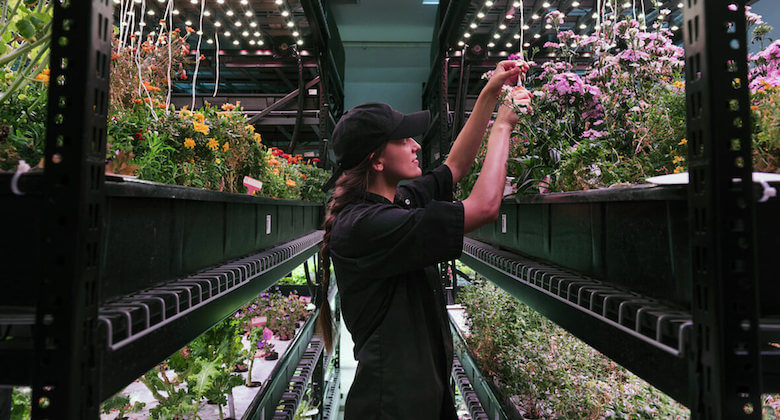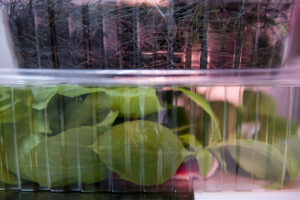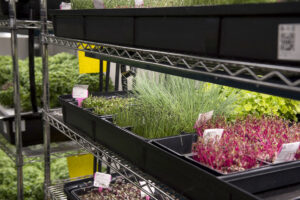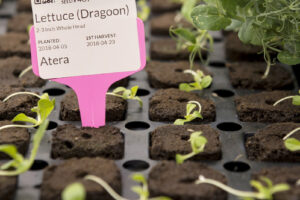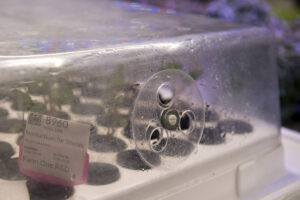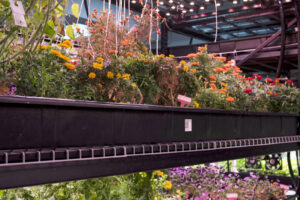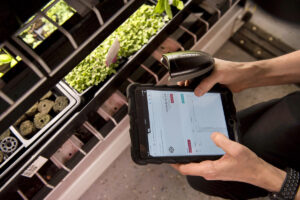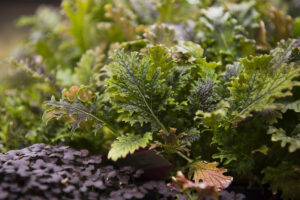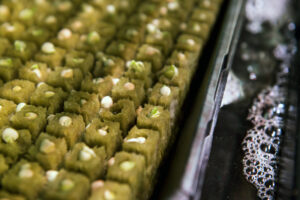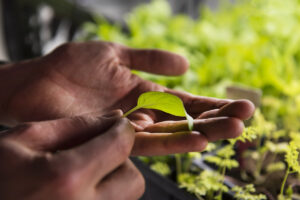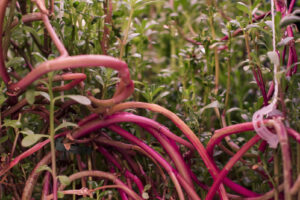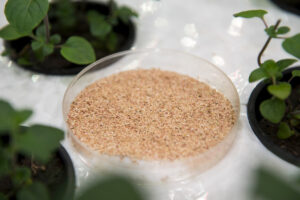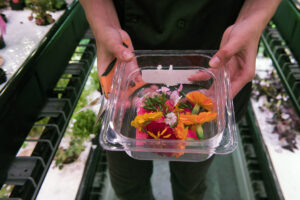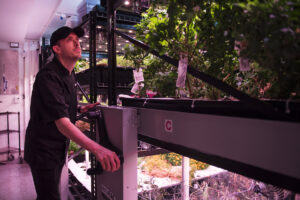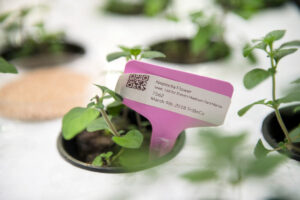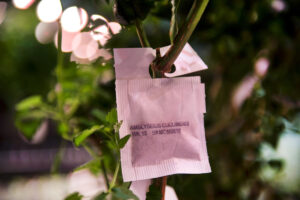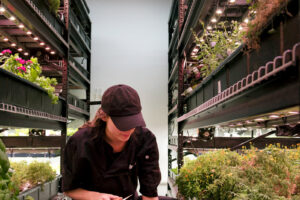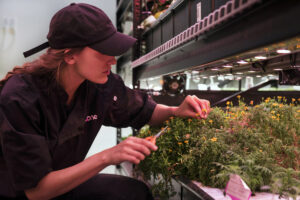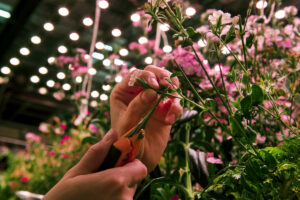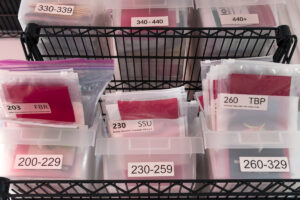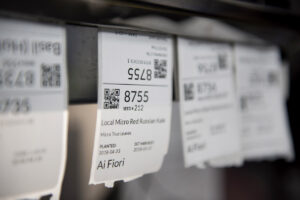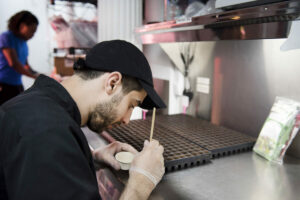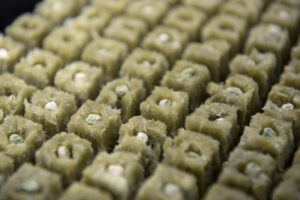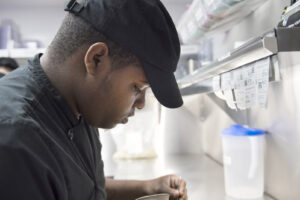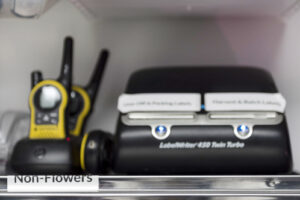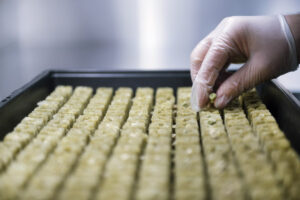
Editor’s note: We’re chronicling how tech is changing the way we eat and drink as we lead up to this fall’s Food Loves Tech. Our annual deep dive into appropriate food and ag technologies returns to Industry City on November 2–3, 2018 and you can get $20 off the regular admission price while our early bird special lasts.
On one of those unseasonable 40-degree days this April when there was soaking ice-cold rain followed by umbrella-wrecking wind, the weather inside a miniature indoor farm near Manhattan’s City Hall was balmy.
Farm.One CEO and founder Robert Laing, in a black chef coat and jeans, surveyed the plants perfuming a 1,200-square-foot growing space, formerly a bicycle gym, in a building that also houses a veterinary clinic, a doggy swimming pool and Atera, a two-star Michelin restaurant serving dinner for $275 a plate. Space-saving expandable library shelves were lined with dozens of hydroponic plants grown in a water-based nutrient system instead of soil: snap peas, green sorrel, lemon basil, red mizuna, lemon gem marigold. “Here’s one of my favorites,” Laing said, picking a leaf and a tiny flower snugly tucked beneath rows of bright LED lights. “It’s called “nepitella,” a flowering herb from Tuscany. Italian chefs are excited to see it in New York City because sometimes they haven’t seen it in years. It’s a little bit minty—the flowers have a powerful flavor for something so small.”
Read more: A Guide to Indoor Farming Techniques
Laing specializes in selling such rare and unusual herbs, greens and edible flowers to mostly high-end restaurants—from Le Turtle on the Lower East Side to Daniel uptown and Atera upstairs. Those restaurants’ chefs are willing to pay a premium for hard-to-find produce harvested and delivered the same day. “The growing climate in New York is difficult,” Laing said. “So chefs here really have a tough time getting rare produce—they have to ship it from miles away and by the time it gets here it’s not at its best. I really wanted to create a way to grow interesting things in the heart of the city year-round.”
In a town of eight million, Farm.One is part of a rising movement to cultivate produce where large numbers of people live by using high-tech systems and smart greenhouses placed at grocery stores, in basements and even inside cargo vessels. Leading restaurants have embraced these futuristic farms for a range of reasons, including variety, ingredient quality and virtually unlimited availability in all seasons.
Critics, however, question whether high-tech farming in confined spaces will be destined to cater only to elite restaurants, especially considering the much bigger national marketplace flooded with cheaper produce from California and Arizona. Chefs also debate taste. Some are grateful to have local hydroponic produce to flavor their dishes in all seasons. Others swear the produce is inferior to herbs and vegetables from a dirt farm with the characteristic flavor of the soil where they grow.
There are also questions about what will happen if these indoor urban farms really take off, including whether they might undercut local farms on the metropolitan fringe. “The need to protect and preserve that open space is real,” says Dan Barber, the chef and co-owner of Blue Hill in Manhattan and Blue Hill at Stone Barns in Pocantico Hills, New York, and one of the pioneers of the farm-to-table movement. “To divert from that in any way seems to be a lost opportunity—even though I see the excitement of doing some salad greens in a shipping container.”

Urban farming business and distribution models vary almost as widely as the types of plants being cultivated. Farm.One’s website recently listed about 18 different types of produce ranging from a 10-count of yarrow or marigold leaves for $5 available to online customers to papalo (an ancient Mexican herb similar to cilantro) starting at $8.75 an ounce for restaurant orders only. “We’re doing this at the high end because that’s where we know we can make money and have a sustainable business,” Laing says. He envisions expanding Farm.One in New York and in other cities with a continued focus on providing produce to restaurants and being a model to make such produce more accessible to consumers. “It’s really cool to think in a city like New York there are thousands of spaces like this,” he says. “The technology is there. I think the applications can spread.”
Indeed, technology is the central focus of most city farms. Smallhold, founded in 2017, pre-grows gourmet mushrooms that are finished in restaurants and a grocery store in leased climate-controlled cases lit by blue fluorescent lights and monitored and operated remotely by the company’s growers in Bushwick. Also located in Brooklyn, Square Roots, recently launched by Kimbal Musk (younger brother of Tesla boss Elon Musk) and his partner, Tobias Peggs, is helping young entrepreneurs use the latest innovations to farm in cargo vessels; a 320-square-foot container can purportedly supply about as much produce as a two-acre farm.
Read more: What Would Make Urban Agriculture in New York City More Equitable?
Gotham Greens, with locations in New York and Chicago, uses automation and sensors that can detect light levels, carbon dioxide, temperature and humidity to operate four rooftop hydroponic greenhouses producing about a dozen types of lettuces and herbs. The greenhouses represent 170,000 square feet of combined growing space. In 2014 the company opened a greenhouse atop a Brooklyn Whole Foods—the first commercial-scale rooftop greenhouse integrated into a supermarket. “Our growers are harvesting, packaging and then the product goes down to the store,” Gotham Greens director of marketing Nicole Baum says. “We’ve reduced food miles to food footsteps.”
Despite those lower transportation costs, investors are concerned about the profitability of so many start-ups. “Most urban farms are costly and therefore their prices are higher than what one can pay at a grocery store for a field-grown product trucked across the country,” says Dan Pullman, managing partner of Fresh Source Capital, a company investing in local food and agricultural systems. “You’ve got to make money on this stuff. Otherwise it doesn’t work.”
Baum said Gotham Greens’ prices are competitive with local and organic lettuce brands, about $3.99 for a 4.5-ounce container. Still, the company is a small-scale producer vying for consumers faced with a financial decision: pay the price for local organic, save 50 cents by purchasing a well-known organic brand, or a whole dollar for conventional greens from California or Arizona. “There is always a consumer who will pay for value,” Pullman says. “Gotham may be in a good position because they’ve got loyal regional markets, but replacing lower-cost producers will be tough.”

A puree of Gotham Greens’ basil spinach currently stars on one of the atbreads served in Gramercy Tavern. “They’ve given us access to harvested greens in even the cold weather months,” executive chef Michael Anthony says. “That makes for exceptional high quality from a restaurant perspective.”
But some chefs say hydroponic lettuce will never rival the taste of lettuce grown in the earth. “I’ve never tasted any hydroponics that I think are really that delicious,” says Dan Barber of Stone Barns, which grows some of its lettuce in a nearby greenhouse and sources more from local farms. “Sure, the quality in terms of the way the product looks and the yield can be more consistent by being contained because you’re not subject to the whims of nature—but that doesn’t mean it’s better.”
Read more: Gramercy Tavern and Untitled Chef Michael Anthony on the Role of Tech in Restaurants
What’s more, Barber adds, “the side effect of the excitement about indoor farming takes away from the investment and intellectual capital in creating systems for agriculture that are still very viable surrounding major metropolitan areas.” For him, it’s important to preserve the farmscape, healthy agriculture and organic philosophies based on sustainable land use and feeding the soil, not just the plant.
Dave Chapman, owner of Long Wind Farm in Vermont, is on the board of the Real Organic Project, an organization created to challenge the USDA’s recent decisions to certify hydroponic produce and scrap rules about animal welfare. While he’s not opposed to hydroponic farming—“some of my good friends do it”—he wants the methods to be transparent so consumers understand the produce isn’t grown in soil. “This is happening,” he says. “We can’t be food fascists—don’t grow that way! As long as farmers are being honest about how they’re growing, people will decide over time what they think.”
If the glow of LED lights in pockets around the city is an indicator of how much New Yorkers appreciate freshly grown local produce, the urban farming trend may continue to spread. As long as those farms are profitable, entrepreneurs will invest, restaurants will buy—and diners will clean their plates.
Produced in collaboration with the Food & Environment Reporting Network, an independent, non-profit news organization.


